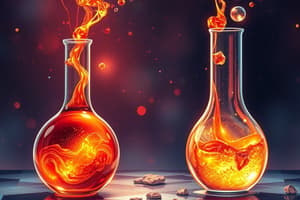Podcast
Questions and Answers
What are the defining properties of solids that distinguish them from liquids and gases?
What are the defining properties of solids that distinguish them from liquids and gases?
Solids maintain a fixed shape, volume, and cannot be compressed or poured.
How do liquids behave differently than solids with respect to volume when placed in different containers?
How do liquids behave differently than solids with respect to volume when placed in different containers?
Liquids take the shape of their container but maintain the same volume regardless of the shape.
What makes gases easily compressible compared to solids and liquids?
What makes gases easily compressible compared to solids and liquids?
Gases have particles that are far apart, allowing them to be compressed easily.
In what ways can gases be perceived despite being generally invisible?
In what ways can gases be perceived despite being generally invisible?
Describe the behavior of gases in a closed container compared to solids and liquids.
Describe the behavior of gases in a closed container compared to solids and liquids.
What occurs to the volume of a gas when it's compressed, and how does it compare to solids and liquids?
What occurs to the volume of a gas when it's compressed, and how does it compare to solids and liquids?
Flashcards are hidden until you start studying
Study Notes
States of Matter
- Matter encompasses everything visible and tangible in the universe.
- Matter is categorized into three primary states: solids, liquids, and gases, each with distinct properties.
Solids
- Maintain a definite shape and volume, not conforming to their container.
- Occupy a fixed amount of space and do not compress or pour.
- Exhibit rigidity, resisting deformation under pressure.
Liquids
- Adapt to the shape of their containers, while maintaining a constant volume.
- Can be poured and are incompressible like solids.
- Volume remains unchanged regardless of the container's shape, emphasizing fluidity.
Gases
- Exhibit fluid-like behavior by flowing and expanding to fill any closed container.
- Highly compressible, allowing their volume to vary significantly.
- Typically weigh less than solids and liquids, with most gases being invisible and imperceptible to touch; however, some can be detected through smell or air movement.
Studying That Suits You
Use AI to generate personalized quizzes and flashcards to suit your learning preferences.




